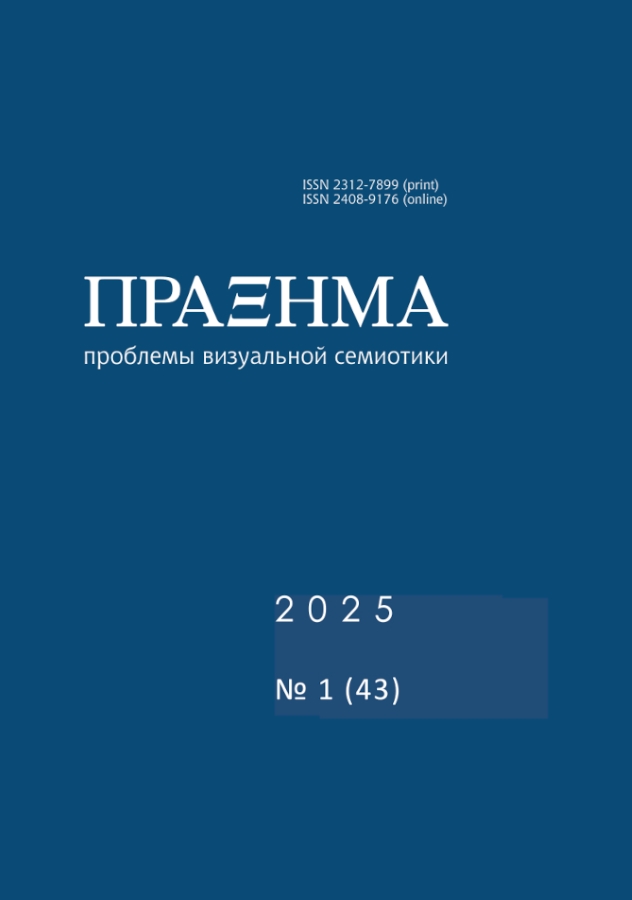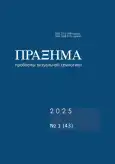Репрезентация детства в школьной драматургии эпохи Реформации
- Авторы: Лурье З.А.1
-
Учреждения:
- Национальный исследовательский университет Высшая школа экономики
- Выпуск: № 1 (2025)
- Страницы: 38-69
- Раздел: СТАТЬИ
- URL: https://journal-vniispk.ru/2312-7899/article/view/291925
- DOI: https://doi.org/10.23951/2312-7899-2025-1-38-69
- ID: 291925
Цитировать
Полный текст
Аннотация
Ключевые слова
Об авторах
Зинаида Андреевна Лурье
Национальный исследовательский университет Высшая школа экономики
Email: zlure@hse.ru
кандидат исторических наук, научный сотрудник института образования Москва, Россия
Список литературы
- Воробьева, Митченко 2022 – Воробьева Л. Б., Митченко З. В. Социокультурный феномен детства в аспекте этнопедагогики // Самарский научный вестник. 2022. Т. 11, № 1. С. 288–292.
- Гис, Гис 2002 – Гис Ф., Гис Дж. Брак и семья в Средние века. М.: РОССПЭН, 2002.
- Доронина 2021 – Доронина С. Г. Философское исследование феномена детства: проблемы и перспективы // Социум и власть. 2021. № 1 (87). С. 127–137.
- Калверт 2009 – Калверт К. Дети в доме: материальная культура раннего детства, 1600–1900. М.: Новое Литературное Обозрение, 2009.
- Корзо 2021 – Корзо М. А. Школьный учебник и детские книги для чтения XVII – начала XIX в. о воспитании добродетельного человека: избранные примеры // Дети и детство в истории культуры: современный междисциплинарные исследования. Тула: Тульский гос. пед. ун-т им. Л.Н. Толстого, 2021. С. 38–48.
- Мелик-Гайказян 2022 – Мелик-Гайказян И. В. Семиотическая диагностика расщепления траекторий мечты о прошлом и мечты о будущем // Электронный научно-образовательный журнал «История». 2022. Т. 13, № 4. doi: 10.18254/S207987840021199-7. URL: https://history.jes.su/s207987840021199-7-1/
- Мойса, Ростиславлева 2021 – Мойса А. А., Ростиславлева Н. В. Лютер и Кранах: изобразительное искусство в рамках немецкой Реформации // Преподаватель ХХI век. 2021. № 1-2. С. 257–269.
- Лурье 2013 – Лурье З. А. Первомученик Стефан в агиографической традиции Средневековья и раннего Нового времени // Религия. Церковь. Общество: исследования и публикации по теологии и религии / под. ред. А. М. Прилуцкого. СПб.: Светоч, 2013. Вып. 2. С. 185–207.
- Лурье 2019 – Лурье З. А. «Ева» Сикста Бирка как педагогический текст // Источники исследования о педагогическом прошлом: интерпретация проблем и проблемы интерпретации: сб. науч. тр. междунар. науч.-практ. конф. М.: МПГУ, 2019. С. 278–284
- Лурье 2021a – Лурье З. А. Основные принципы протестантской дидактической книги: особенности формирования образа человека // Образовательные пространства и антропопрактики города / под ред. В.К. Пичугиной. М.: Аквилон, 2021. C. 106–129.
- Лурье 2021b – Лурье З. А. Патриарх Авраам в сценическом и городском пространстве раннего Нового времени // Электронный научно-образовательный журнал «История». 2021. Вып. 11 (97): Границы медиевистики и безграничное Средневековье. doi: 10.18254/S207987840012808-7
- Лурье 2022 – Лурье З. А. Театр в педагогике Филиппа Меланхтона // Вестник Томского государственного педагогического университета. 2022. Вып. 5 (223). С. 157–167.
- Лурье 2023 – Лурье З. А. Листая альбом А. Н. Немилова «Лукас Кранах»: художник и Реформация // Proslogion: Проблемы социальной истории и культуры средних веков и раннего Нового времени. 2023. № 7 (1). С. 199–210.
- Лютер 1994 – Лютер М. К советникам всех городов земли немецкой: О том, что им надлежит учреждать и поддерживать христианские школы (1524) // Лютер М. Избранные произведения / сост. А. П. Андрюшкин. СПб.: Андреев и согласие, 1994. С. 164–184.
- Машевская 2015 – Машевская С. М. Очерки по истории детской театральной деятельности. М.: Совпадение, 2015.
- Надъярных, Уракова 2016 – Надъярных М., Уракова А. От составителей // Детство в англо-американском литературном сознании XVII–XX вв. М.: ИМЛИ РАН, 2016. С. 5–11.
- Полякова 2022 – Полякова М. А. Гуманистический и протестантский подходы к женскому образованию в ΧVI в. // Историко-педагогический журнал. 2022. № 2. С. 91–100.
- Полякова, Лурье 2023 – Полякова М. А., Лурье З. А. «Краткое наставление» Ульриха Цвингли о христианском образовании и воспитании: вступительная статья, перевод и комментарий // Религия. Церковь. Общество: исследования и публикации по теологии и религии / под ред. А. Ю. Прилуцкого. СПб.: Скифия-принт, 2023. Вып. 12. С. 302–327.
- Прокопьев 2002 – Прокопьев А. Ю. Германия в эпоху религиозного раскола. 1555–1648. СПб.: Гуманит. Акад., 2002.
- Ревякина, Девятайкина 2020 – Ревякина Н. В., Девятайкина Н. И. От Средневековья к «Радостному дому»: школы, ученики, учителя итальянского Возрождения (XIV–XV вв.). М.: Росспэн, 2020.
- Ромашина 2021 – Ромашина Е. Ю. Дети и детство в истории культуры // Педагогика. 2021. Т. 85, № 3. С. 122–127.
- Стеценко 2016 – Стеценко Е. А. Детский и взрослый миры в дилогии Марка Твена «Приключения Тома Сойера» и «Приключения Гекльберри Финна» // Детство в англо-американском литературном сознании XVII–XX вв. М.: ИМЛИ РАН, 2016. C. 156–177.
- Толстова, Иванов 2023 – Толстова Е. В., Иванов В. А. Мысли Мартина Лютера об игре в обучении // Вестник Чувашского государственного педагогического университета им. И.Я. Яковлева. 2023. № 1 (118). С. 180–187.
- Хорт 2022 – Хорт А. С. «Драматургия власти», или руководство по идеологическому воспитанию в цикле иллюстраций к пьесе Иоганна Рассела «Игра о воспитании детей» // Исторические исследования. 2022. № 17. С. 101–118.
- Юрьева 2023 – Юрьева А. В. Пространство детского мира: проблема трансформации // Дискурс. 2023. Т. 9. № 4. С. 5–19.
- Arnold 1996 – Arnold K. Familie – Kindheit – Jugend // Handbuch der deutschen Bildungsgeschichte / Hrsg. von N. Hammerstein, A. Buck. Bd. 1: 15. bis 17. Jahrhundert. Von der Renaissance und der Reformation bis zum Ende der Glaubeskämpfe. München: Beck, 1996. S. 135–152.
- Brunner 1980 – Brunner O. Das ganze Haus und die alteuropäische „Ökonomik“ // Neue Wege de Verfassungs- und Sozialgeschichte. Götingen: Vandenhoeck, 1990. S. 103–127.
- Brüggemann, Brunken 1987 – Brüggemann Th., Brunken O. Handbuch zur Kinder- und Jugendliteratur: Vom Beginn des Buchdrucks bis 1570. Stuttgart: Metzler, 1987.
- Ehrstine 2002 – Ehrstine G. Theater, culture, and community in Reformation Bern, 1523–1555. Leiden: Bril, 2002.
- Fecher 1840 – Fecher D. A. Thomas und Felix Platter: 2 Autobiographieen. Ein Beitrag zur Sittengeschichte des XVI. Jahrhunderts / Hrsg. von D. A. Fechter. Basel: Seul u. Mast, 1840.
- Füssel 2009 – Füssel M. Fest – Symbol – Zeremoniell. Grundbegriffe zur Analyse höfischer Kultur in der Frühen Neuzeit // Soziale und ästatische Praxis der höfischen Fest-Kultur im 16. und 17. Jahrhundert / Hrsg. von K. Dickhaut. Wiesbaden: Harrassowitz, 2009. S. 31–53.
- Hess 2005 – Hess D. Mit Milchbrei und Rute: Familie, Schule und Bildung in der Reformationszeit. Nürnberg: Verlag des Germanischen Nationalmuseums, 2005.
- Higginbotham, Johnston 2018 – Higginbotham J., Johnston M. A. Queering Childhood in Early Modern English Drama and Culture. Palgrave Macmillan, 2018.
- Hilliard 1989 – Hilliard M. W. To sacrifice a child: The development of a theme in medieval and Renaissance drama. Tennessee: University of Tennessee, 1989.
- Kaufmann 2006 – Kaufmann Th. Konfession und Kultur: Lutherischer Protestantismus in der zweiten Hälfte des Reformationsjahrhunderts. Tübingen: Mohr Siebeck, 2006.
- Kindermann 1986 – Kindermann H. Das Theaterpublikum der Renaissance. Salzburg: Müller, 1986. Bd 2.
- Kolb 1987 – Kolb R. Teaching the Text the Commonplace Method in Sixteenth Century Lutheran Biblical Commentary // Bibliothèque d' Humanism eet Renaissance. 1987. Vol. 49 (3). P. 571–585.
- Lamb 2009 – Lamb E. Performing Childhood in the Early Modern Theatre: The Children's Playing Companies (1599–1613). New York: Palgrave Macmillan, 2009.
- Lorenz 2014 – Lorenz N. The functional Shift of Violence in Reformation Theater in Saxony // Power and Violence in Medieval and Early Modern Theater / ed. C. Dietl. Göttingen: V&R unipress, 2014. P. 195–214.
- Metz 2013 – Metz D. Das protestantische Drama: Evangelisches geistliches Theater in der Reformationszeit und im konfessionellen Zeitalter. Köln: Bohlau Verlag, 2013.
- Ozments 1983 – Ozments S. Untersuchung zum Familienleben der Reformationszeit. London, 1983.
- Parente 1997 – Parente A. J. Religious Drama and the Humanist Tradition: Christian Theater in Germany and in the Netherlands 1500–1680. Leiden; New York: E.J. Brill, 1997.
- Salvarani 2019 – Salvarani L. Oporinus’ Dramata Sacra anthology (Basel, 1547): a historical and educational reading // Religion. Church. Society: Research and Publications in the Field of Theology and Religious Studies. 2019. Is. 8. Р. 160–183.
- Schöpflin 2010 – Schöpflin K. Susanna’s career in Reformation drama: A reception-historical perspective with an outlook on fine art // Deuterocanonical Additions of the Old Testament Books / ed. by G. G. Xeravits, J. Zsengellér. Berlin; New York: De Gruyter, 2010. S. 198–213.
- Schrand 1992 – Schrand P. Frau und Ehe im biblischen Drama der Reformationszeit: Dissertation zur Erlangung des Grades eines Doktors der Philosophie. Osnabruck, 1992.
- Schreckenberg, Schubert 1992 – Schreckenberg H., Schubert K. Jewish Traditions in Early Christian Literature. Leiden: Brill, 1992.
- Sheffler 2008 – Sheffler D. L. Schools and Schooling in Late Medieval Germany, Regensburg 1250–1500. Leiden: Brill, 2008.
- Stone 1964 – Stone L. The Educational Revolution in England 1560–1640 // Past and Present. 1964. Vol. 28. P. 41–80.
- Tiemann·2020 – Tiemann·M. Josef und die Frau Potifars im populärkulturellen Kontext: Transkulturelle Verflechtungen in Theologie, Bildender Kunst, Literatur, Musik und Film. Wiesbaden: Springer, 2020.
- Timmermann 1986 – Timmermann W. Theaterspiel als Medium evangelischer Verkündigung. Zu Aussage und Funktion der Dramen Paul Rebhuns // Archiv für Kulturgeschichte. 1986. Bd. 66. S. 117–158.
- Tschopp 2010 – Tschopp S. S. Protestantisches Schultheater und reichsstädtische Politik: Die Dramen des Sixt Birck // Humanismus und Renaissance in Augsburg: Kulturgeschichte Einer Stadt Zwischen Spätmittelalter Und Dreißigjährigem Krieg / Hrsg. von G. M. Müller. Berlin: Walter de Gruyter, 2010. S. 187–215.
- Waschof 2007 – Washof W. Die Bibel auf der Bühne: Exempelfiguren und protestantische Theologie im lateinischen und deutschen Bibeldrama der Reformationszeit. Münster: Rhema-Verlag, 2007.
Дополнительные файлы







